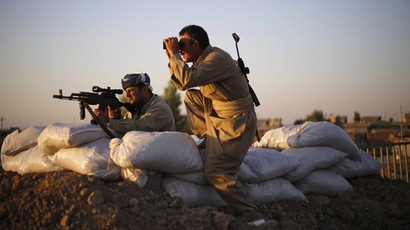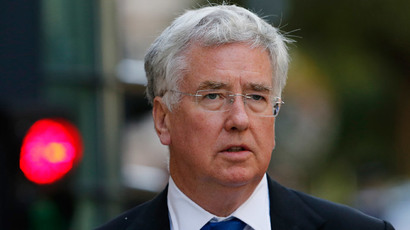Syrian Kurds repulse Islamic State militants in Kobani - watchdog
Amid heavy casualties on both sides, Islamic State [IS] militants have been forced to pull back from their assault on the Syrian town of Kobani, according to an international watchdog group.
IS militants, after briefly gaining control of Kobani's central Freedom Square following a sneak attack on Kurdish forces, were forced to retreat after sustaining losses, according to the Syrian Observatory for Human Rights (SOHR), a UK-based Syrian opposition group.
READ MORE: UK urges Turkey to join military alliance against ISIS
“Violent clashes took place at the outskirts of the square
leading to the death of some IS militants, while others retreated
to the eastern neighborhoods in the city of Kobani,” the
Syrian Observatory for Human Rights reported.
More than 550 people have been killed since the military assault
of Kobani by the militants of Islamic State (also known as ISIS,
or ISIL) began on September 16, the Observatory reported.
The victims include some 20 civilians, 226 fighters of the
Kurdish People's Protection Units (YPG), and up to 10 from groups
that are lending support to the YPG, including other casualties.
The monitoring organization warned that, given the difficulties
in establishing definite figures amid the violence, not to
mention intense secrecy from both sides, the actual number of
those killed could be twice the figure listed.
There had been fears that the last escape route for the besieged
Kurds into bordering Turkey was blocked following the short-lived
IS gains.
Turkey has been reluctant, given its own restive Kurdish
population that has in the past sought self-rule, to allow
Turkish Kurds to join their fellow Kurds fighting in Kobani
against IS.
“IS is getting supplies and men, while Turkey is preventing
Kobani from getting ammunition,” SOHR head Rami Abdelrahman
told Reuters.
“Even with the resistance, if things stay like this, the
Kurdish forces will be like a car without fuel,” he warned.

Kobani remains under attack by IS forces from the east and south,
while fighting has descended into running street battles,
according to the head of Kobani's defense council, Esmat
Al-Sheikh.
“The [American] air strikes are benefiting us, but Islamic
State is bringing tanks and artillery from the east. We didn't
see them with tanks, but yesterday we saw T-57 tanks,” he
said.
Despite some 50 aerial strikes on IS positions by the United
States against IS positions around Kobani, there remains the
possibility, according to US officials, of IS gaining full
control of the Syrian city in coming days, which would provide
the Islamic militants with a huge public relations victory in
their ongoing efforts to attract fresh recruits.
Following the spread of IS forces throughout northern Iraq and
Syria, the United States on September 22 opened airstrikes
against IS targets inside Syria for the first time.
However, like a serpent that grows three heads every time one is
cut off, a new, mysterious group, called the Khorasan Group,
suddenly appeared on the scene in Syria, seemingly distracting
the US military from its stated priority against IS militants
(According to an AP report, the Pentagon launched 46 cruise
missiles at eight locations where the group is believed to be
operational).
READ MORE: Tens of thousands of Kurds protest over ISIS inaction in Europe (VIDEO)
"The strikes were certainly effective in setting back the
Khorasan Group, but no one thinks they were a permanent solution
or a death blow to the threats that come from this cell,"
said Rep. Adam Schiff, D-Calif., a member of the House
Intelligence Committee, AP reported.
Meanwhile, IS still holds over one-third of the Syrian town near
the Turkish border.














